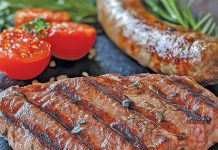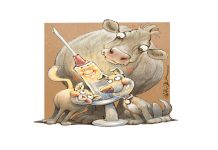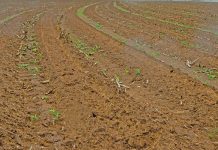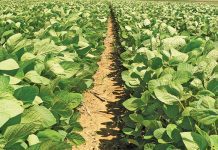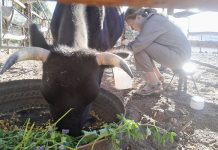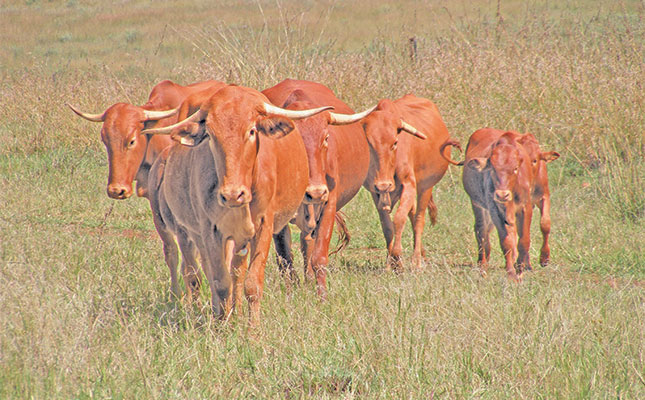
Photo: FW Archive
When it comes to bush encroachment, I prefer the term ‘woody plant proliferation’, as this is a process of changing vegetation and changing habitat over which every farmer has very little control.
The causes of woody plant proliferation shift constantly, depending on many factors.
Zimbabwe offers a unique example of these changing circumstances. In the pie charts accompanying this article, I have taken the unscientific liberty of interpreting what I consider to be the principal driving forces behind woody plant proliferation in Zimbabwe.
Of course, as I have only been around since 1956 and only actively observant since 1978, the period from 1900 to 1980 has a few holes in it.
The influence of fire/soil temperatures on germination of woody plant species
The wattle tree (Acacia mearnsii) originated in Australia. At maturity, around seven years old, the bark can be stripped off and taken to an extraction factory to recover the tannins. Trees are then skilfully cut to fall in longitudinal lines across the land/block.
The largest logs are taken to fire boilers at the extraction factory, for example, or to make furniture, while the remaining brush and logs are left to dry in preparation for burning within the block.
Once the summer rains are acknowledged as ‘under way,’ these lands are set alight. To ensure that there is satisfactory and evenly dispersed heat, the fire is set as a ‘ring’ around the entire land.
Within a period of 10 to 20 days, the land changes from a black and burnt landscape to a carpet of green wattle saplings.
Research shows that while not all Acacia/Vachellia seed require a source of heat to break dormancy, the majority of the seeds from these plants are hard-coated and require varying levels of heat to break the seeds’ dormancy.
It is also well known that seed maturation, depth of seed in the natural seed bank, and the seeds’ ability to germinate only after fire or to germinate both between and after fires promote a specific plant’s ability to dominate invasion.
As an example of this, a comparison of two Australian species, namely A. mearnsii (black wattle) and A. longifolia (golden wattle), shows that the latter has a greater ability to invade.
This arises from the fact that while black wattle germinates only after a fire and requires a high thermal shock to do so, golden wattle is able to germinate both between and after fires, germinating with lower thermal shock and likely following multiple fires from buried seed stock.
In the early 1980s, I spent a most wonderful and informative day with a veteran of Matabeleland. We travelled together for miles along neck-jarring dirt roads and paused between outbreaks of impenetrable thorn thickets.
Our conversation dwelled on these thickets, mostly Dichrostachys cinerea (sicklebush) and V. karroo (sweet thorn), which my companion vowed had been open savannah when he was younger. He was adamant that the cause of the thickets, some of which covered many hectares, was overgrazing.
He explained that grazing early in the season and constant pressure (overgrazing by cattle) allowed the soil to be exposed to the worst of the summer heat long before any chance of useful rain.
It was his opinion that by allowing the soil to heat up without the protective cover of grass, the seed of the invasive plants would have broken dormancy, and with the onset of the summer rains would ‘explode’ into a germination of woody plant saplings.
And so, it seems ungainful to ignore that a significant driver of woody plant proliferation is caused by the overgrazing of cattle on grasslands and the impact of thermal shock at the soil surface in the scarification of variable species responsible for woody plant proliferation.
Indeed, the principal drivers offered by research for the proliferation of woody plants include:
- Overgrazing;
- The mean reduction and lower intensity of natural fires that more recently have lacked sufficient fuel (grass, and so on) due to overgrazing and are therefore no longer hot enough to eradicate woody plant saplings and maintain the mosaic on the savannahs between the grass and tree layers;
- Soil nutrient/fertility disturbances;
- Spread of seeds by livestock and wild animals;
- Absence of or reduction in large herbivory animals, such as elephants;
Irregular rainfall; and - Elevated levels of atmospheric carbon dioxide (CO2).
Determining causes of proliferation
More than 40 plant species in Southern Africa (and this continues to multiply) have been identified as responsible for the increased density of woody plant proliferation, and many of these are well-recorded pioneer species.
The best description that I have been offered of a pioneering species is ‘a species that fills the gap between what there was and what it will become’.
Through the El Niño-influenced drought of 2023/24, I briefly worked on a farm just a short distance east of Harare. A vlei area of approximately 30ha had been converted into a monoculture of the pioneer grass species Sporobolus pyramidalis (giant rat’s tail grass).
I had a choice to burn or mow the area and chose mowing to avoid losing the litter. Mowing was completed early December, and within a period of four weeks there were multiple very obvious sweet thorn saplings. I found this extraordinary.
Across the fence and as a continuation of the vlei, our neighbour had lost his entire vlei to a very hot fire in October. The herd of cattle on this neighbouring farm was reared and grazed there.

Not a single sweet thorn or sapling was visible across the fence on that property! So, how had these multiple saplings of sweet thorn come to be established in numbers on this side of the fence?
The reason seemed obvious. The vlei on this side of the fence had carried very large numbers of cattle the previous year, all of which had been relocated from farms many miles away that had exhausted their grazing. The sweet thorn seed had moved with the cattle, and it was likely that a percentage of them had been scarified in the alimentary canal.
But this raised the question: had the seed that passed through the alimentary canal and lost dormancy been in this state of non-dormancy until I removed the dense shade of giant rat’s tail cover?
Or, had the seed been dormant, and had the excessive daytime heat that reached the seed in the absence of the cooling shade been sufficient thermal shock to break dormancy in the seed?
From experience, I know how difficult it can be to identify the cause of a sudden upsurge or appearance of plants responsible for woody plant proliferation.
It highlights the need to ensure that cattle moving from an area with plants acknowledged as being responsible for increasing woody plant density to one with no or very limited ‘invasion’ need to be controlled in some manner.
All plants require nutrition and water. Woody plants, responsible for invasive behaviour, are no exception. With good rainfall, expect recurrent and considerable woody plant expansion.
Long, hot, and dry seasons pause and reduce the ‘pulse’ of woody plant proliferation; wet seasons will greatly enhance the recruitment and extended pulse of woody plant proliferation, which will be further encouraged by soils with higher nutritional values.
Central Zimbabwe, recognised for its deep, nutritious soils and agricultural potential, has, over the past decade, experienced later rains, hotter temperatures, and extended intraseasonal droughts.
Throughout this bountiful and productive area, there are many threatening pockets and thickets of plants responsible for woody plant proliferation. There will be a multitude of hard-coated seeds of these plants, anxious for the heat and rains that they require to germinate. In the deep, nutritious soils these plants will explode.
So, we need to decide if we (a) fight bush encroachment with every tool to hand, or (b) find a way to live with woody plant proliferation.
As a life-long cattleman, and very proud to be a part of this wonderful business and lifestyle, I am inclined to believe that we would be better off with finding a way to live with woody plant proliferation.
Scenario A: do we fight?
Never, that I know of, in the past 80 years or more has it been economical to fight bush encroachment. However, if we go this route, fire has always been the best (cheapest) option, and good husbandry of cattle with a balanced inclusion of wild herbivores and veld management practices have also been essential.
As mentioned before, overgrazing can lead to a proliferation of woody plants, so farmers need to carefully consider this when grazing their animals. The beef industry needs early spring and summer rains, for example, followed by later summer rains that develop the following winter’s volume of dry matter.
The cornerstone to avoid overgrazing and prevent woody plant proliferation is the timely and managed dispersal of cattle where droughts are forecast or large gaps (intraseasonal droughts) between rainfall appear in the course of a rainy season.
Management decisions, based on the store of dry matter in the fodder bank and taken at the conclusion of each rainy season, are essential. A balance between available dry matter and stock on hand (including wild herbivores) should be calculated and a destocking exercise carried out accordingly.
The alternative to destocking would be a calculation of the cost of supplementary feed for all stock, and a more limited destocking exercise.
Preventing woody plant proliferation is not always possible, and there are various methods to destroy or retard bush encroachment. These include:
- Aerial spraying with arboricides. It’s expensive, not always selective and can have very long-term downstream effects;
- Mechanised removal. It’s fast, but expensive and indiscriminate;
- Specialised mechanical removal aimed to recover biomass. It’s fast, expensive (although biomass retained for sale will lower costs under professional management), and will require constant follow-up;
- Hand-managed mechanical removal with bush cutters/chainsaws, bush picks, and axes. It’s slow, and will require considerable follow-up even with the use of herbicides;
- Manual removal. It’s expensive and largely ineffective; mostly, areas of woody plant encroachment manually removed will re-establish within a period of five years. To be able to entirely remove encroachment, the entire root system requires to be dug out.
It was once a principle of tobacco farms to pay labour per kilogram for roots removed from future tobacco lands, but without micromanagement, this leads to very limited root removal. Constant follow-up cleaning is likely required; - Manual removal with manual application of arboricides. It will require a high level of management to insist on each and every stump being treated. Arboricides will require to be immediately applied and may in fact be best applied to plants such as Lantana camara at the end of the main summer rains when these plants are seasonally returning carbohydrate to the root zone. Constant follow-up cleaning is likely necessary;
- Limited manual removal (thinning) with arboricides. It requires high levels of management and follow-up;
- Cut and slash. This method is indiscriminate and causes considerable coppicing and pollarding, which results in stem growth that is more than twice as efficient in growth due to root stores of both carbohydrates and carbon. It will encourage tree density in unmanaged areas and subdue grass cover even further;
- Flame throwers. This will probably cause considerably more damage than good. No follow-up is required, as vegetation is unlikely to grow here for a while;
- Use of a large number of goats or other browsers. At the probable expense of a productive goat unit (lowering weaning percentages), this may be a useful method to at least force the canopy of impenetrable outbreaks of woody plant proliferation upwards, allowing sunlight through.
If goats were fed in the evening, it would likely be the only way to retrieve them from the thicket’s spiny defences. If goats were given seeds of viable grasses and cover crops in their feed, these seeds may germinate as the woody plants gain in height and permit sunlight through the cool protective gloom.
Addenbrooke points out two ways farmers can deal with bush encroachment: fight it, or learn to live with it.
Scenario B: learn to live with it
The evidence of global warming, caused by the increase in atmospheric CO2 over the past 220 years from 280 parts per million to 420 parts per million, is a fact.
Research insisting that growing atmospheric volumes of CO2 have become the single greatest cause for an ever-evident change in vegetation and the motivation for woody plant proliferation to grow denser in Southern Africa is difficult to challenge.
In the context of Southern Africa, and my own life on the horizonless savannahs, I am not convinced that CO2 has until recently been the main driver of woody plant proliferation.
In my own brief life span, my observations have led me to believe that the main influencers of the proliferation of woody plants have been of our own making, and a second act of nature that remains far less sensational.
There was a noticeable change in the nature of rainfall following the summer of 1982/83.
Such a deviation in the manner in which the summer rains over much of Zimbabwe presented required, in my own mind, a far less subtle factor than gradually increasing density in atmospheric CO2. There needed to have been a considerably blunter instrument to cause these dramatic and noticeable changes.
We have largely tended to overstock grazing. We have mostly ignored the need to destock as a management practice following drought and poorer seasons of rainfall. We have failed to destock going into disappointing summer rains and, to a very large degree, failed to understand and adhere to the measure of a large livestock unit.
Our grazing areas, noticeably since the summer of 1982/83, had begun to change. This ‘change’ was due, at first, to the possibility of two ‘invisible’ but gradual global warming events that we were unaware of.
First, there were increasing atmospheric CO2 and the possibility of abnormal movements of high-altitude jet streams and/or ocean currents that in turn began to shift the influence of major rain weather bands, such as the intertropical convergence zone.
Second, there was also the South African ocean high system and the development of cyclones in the Mozambique Channel.
These ‘invisible’ climatic changes have expressed themselves in ever-decreasing amounts of spring rainfall (September/October and early November), and greater and less reliable falls of rain through December, January and February.
Intraseasonal droughts have multiplied, daytime temperatures have increased, and the wind direction following rain has become a more dominant and hostile south/south-east that to a great extent has replaced the ’greenhouse’ wind from the north and north-east.
It seems possible, even likely, that these largely imperceptible influencers of climate have gradually over time heated soil surfaces to a point where scarification of woody plant seeds has become viable for what are now the most prolific proliferators: sweet thorn, A. mellifera (blackthorn), Colophospermum mopane (mopane), Terminalia sericea (clusterleaf), and sicklebush.
It cannot be dismissed that plants such as sweet thorn have evolved rapidly over the past 40 years to permit their hard-coated seeds to break dormancy at temperatures that match peak soil temperatures.
Consider the article ‘Want modern proof of evolution? Look at the elephants of Mozambique’, written by Tom Hale and edited by Francesca Benson. Through the civil war in Mozambique between the years 1977 to 1992, a mere 15 years, both Frelimo and Renamo prolifically poached elephant populations for the valuable resource of ivory.
A 2021 study published in the journal Science found that the frequency of tuskless females in one population had risen from 52 elephants (18,5% of the total population) in the pre-war period to 108 (50,9% of the population) in the post-war period.
Using statistical analysis, the researchers were able to show that this rise in tusklessness was the direct result of intense poaching. Simply put: the tuskless elephants were more likely to survive the period of hardship, and therefore passed on their genes because they didn’t possess any ivory.
There is undeniable evidence of a transfer in the grass layer, where decreaser grasses have been replaced by increaser species.
In many areas, increaser grasses are now gone and been replaced by invader and pioneer species of grass, demonstrating visibly our disconnect between the annual requirement to constantly match herd sizes to our available dry matter resource and our ignorance in the interpretation of what a large stock unit is.
As atmospheric CO2 levels continue to rise, woody plants will benefit and continue to become denser due to a raft of immediate advantages:
- By utilising their C4 (photosynthetic) pathway, plants utilise and sequester CO2 with the added benefits of increasing levels of CO2 ‘fertilisation’;
- Plants that utilise the C4 photosynthesis increase the CO2 concentration around the major CO2-fixating enzyme rubisco. This increased concentration of CO2 in C4 plants and the plants’ increased rate of photosynthesis and reduced photorespiration make them more water efficient;
- Via the symbiotic relationship with soil bacteria such as Rhizobia, the plants take nitrogen gas in the air and convert it into a form that they can use directly; and
- C4 plants are more efficient at high temperatures.
Going forward
I see little choice other than to recognise the changes that have happened. The most likely ‘holistic’ scenario going forward is to consider the following when dealing with areas of established and impenetrable woody scrub.
The use of browsers (goats) has been tried with limited success; the goats are able to graze only from the bottom of proliferating woody plants and this limits their use, except for the mild opportunity that this grazing pattern may, over many years, force the woody plants to grow taller and faster, thereby permitting earlier sunlight to gain access to the soil beneath the woody plants.
It is necessary, too, that the goats themselves must be able to constantly evolve and become taller in order to reach the ever-heightening browse line.
It must further be considered that the perimeter plants in these impenetrable thickets of woody plant species have developed defensive mechanisms such as thicker and more ‘corky’ bark and higher plant populations to avoid fire damage.
Long periods of cold elimination temperatures are unlikely to destroy woody plant proliferation in the midst of a global warming phenomenon. Long, dry, and very hot periods (drought) are likely the most appropriate times to chip away at attempting to remove a percentage of this woody scrub.
There is no doubt that during times of increasing aridity these areas of woody plant proliferation are at their most vulnerable and decrease in density. A combination of browsers, including kudu, nyala, giraffe, rhino and elephant would be considerably more effective than goats.
The reintroduction and protection of wild life (certainly in Zimbabwe) is an absolute cornerstone of living with, and controlling the increasing density of woody plant proliferation, and must include species like warthogs, wild pigs and bush hares.
Woody plant proliferation on soils with an improved nutrient content and higher rainfall incidence that are already established may lend themselves to being converted to useful short-term timber. A practice of constantly removing lower branches on an annual basis from thinned scrub will force the plants to grow taller and faster.
An annual, selective removal of these developed ‘trees’ will offer useful timber and attract herbivores under these ‘trees’ to feed on their nutritious fruit (pods).
It is the constant presence of these herbivores, attracted initially to the feast of pods, but subsequently as a result of their manure and hoof turbulence, that encourages strong stands of perennial grasses such as Panicum maximum (guinea grass) and Cenchrus ciliaris (buffalo grass).
I would suggest that where larger diameter trees are removed to ‘thin out’ areas that the trees are cut as near to the ground as possible and that the remaining stump is bored out in preference to any chemical option to destroy the stump.
Whilst an indiscriminate ‘cut-and-slash’ policy in areas of the great miombo woodlands that cover much of Southern Africa is an unapologetically appalling sight, I have persuaded myself that there may be some use for properly managed control and production of firewood and fencing poles.
Many of the principal trees in the miombo woodlands readily coppice and pollard as soon as they are mutilated in any way. These trees include msasa (Brachystegia spiciformis) and mnondo (Julbernardia globiflora).
In areas where there is established woody plant proliferation with considerable, apparent differences in development, first check the soil type differences between larger and smaller diameter plants. It just may be that the ‘recruitment’ is in fact from the same year with the difference being in the underlying soil.
If it’s possible and economic to remove areas of smaller dense scrub, that would be the first option. But remember to weigh up the preference to do anything with these areas at all if you consider that the underlying soil is of such poor quality that the return in grass cover would be too deficient to take such an action.
If the choice is to attempt to remove dense, small scrub, be sure to remove all roots. If a manual operation is the only feasible way forward, pay per kilogram for root removal.
For areas of larger woody plant proliferation, thin out where necessary, bore remaining stumps, and remove lower branches to as high in the canopy as possible of remaining trees.
There is a real risk that following the El Niño-induced drought and extreme daytime temperatures of 2023, combined with the movement of cattle transported out of areas with zero grazing and into areas of sufficient grazing, that there is now an uncommonly high incidence of dormant or dormancy-broken seed.
With few exceptions, the areas where sufficient grass was likely found and to which cattle were moved through 2023/24 will have been the higher-rainfall areas that are endowed with deeper and more nutrient-rich soils.
The risk for extensive woody plant proliferation in these areas requires constant observation and preparedness for immediate action. The need to dig these plants out on appearance cannot be more specific. Every germinated sapling requires to be entirely dug out and burnt. All roots will need to be removed.
Ley lands (and abandoned lands) can be a tricky business for farmers. These areas may not be correctly followed up due to a lack of cash flow following a bad season, poor prices received for seasonal crops, and changing plans. Often, though, ley lands are not correctly managed for little reason other than that they offer little perceived income.
In many areas of Southern Africa, ley lands are in crop rotations of very high-quality soils. Neglect of these ley lands categorically labels them as ‘disturbed’ land, offering the perfect opportunity for pioneer woody plant and grass species to invade.
Recently, I witnessed a tobacco ley land in a four-year rotation completely overtaken by A. polyacantha (white thorn). The cost to bring this land back into rotation will be considerable.
Equally, I have seen ley lands on poorer-nutrition soils left with no further management that have failed to produce anything other than a few straggling weeds and erosion-caused gullies.
Conclusion
Resolutely and collectively, the responsibility to maintain the optimum and not maximum grazing capacities of beef-producing areas on the savannahs of Southern Africa is the responsibility of beef producers and include (at least) the following: to ensure that herd numbers match the fodder bank throughout the year, and that there is sufficient grass fuel to secure rotational and managed burning.
Also re-introduce wild herbivores and possessively protect these animals.
Our problems with woody plant proliferation, whilst global, are the result of metamorphosing common principle causes within each biome. To expect that each likely cause will replicate itself to the satisfaction of research and arrive at a ‘global’ cause for encroachment is surely not feasible.



